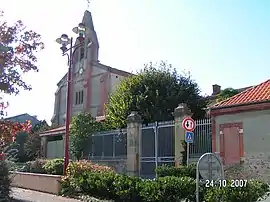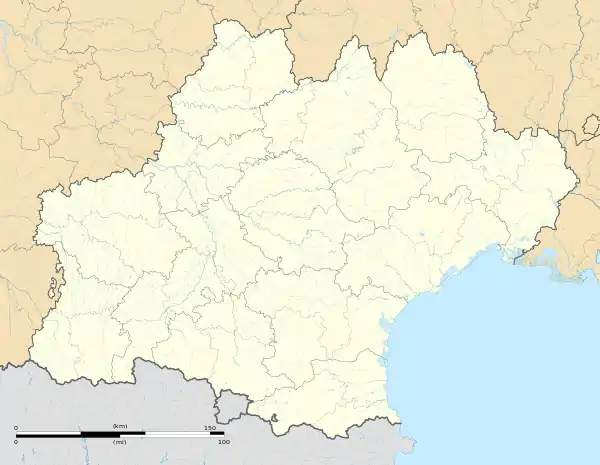Saint-Julien-sur-Garonne
Saint-Julien-sur-Garonne (French pronunciation: [sɛ̃ ʒyljɛ̃ syʁ ɡaʁɔn], literally Saint-Julien on Garonne; before September 2005: Saint-Julien;[3] Occitan: Sent Julian de Garona) is a commune in the Haute-Garonne department in southwestern France.
Saint-Julien-sur-Garonne | |
|---|---|
 The church in Saint-Julien-sur-Garonne | |
.svg.png.webp) Coat of arms | |
Location of Saint-Julien-sur-Garonne | |
 Saint-Julien-sur-Garonne  Saint-Julien-sur-Garonne | |
| Coordinates: 43°14′37″N 1°09′11″E | |
| Country | France |
| Region | Occitania |
| Department | Haute-Garonne |
| Arrondissement | Muret |
| Canton | Auterive |
| Intercommunality | Volvestre |
| Government | |
| • Mayor (2020–2026) | Patrick Lefebvre[1] |
| Area 1 | 8.15 km2 (3.15 sq mi) |
| Population | 551 |
| • Density | 68/km2 (180/sq mi) |
| Time zone | UTC+01:00 (CET) |
| • Summer (DST) | UTC+02:00 (CEST) |
| INSEE/Postal code | 31492 /31220 |
| Elevation | 205–241 m (673–791 ft) (avg. 223 m or 732 ft) |
| 1 French Land Register data, which excludes lakes, ponds, glaciers > 1 km2 (0.386 sq mi or 247 acres) and river estuaries. | |
Geography
The commune is bordered by six other communes: Saint-Élix-le-Château to the north, Salles-sur-Garonne across the river Garonne to the northeast, Lavelanet-de-Comminges to the west, Rieux-Volvestre to the east, Gensac-sur-Garonne across the river Garonne to the south, and finally by Cazères to the southwest.
The river Garonne flows through the commune, making the suffix -sur-Garonne, forming a border with Gensac-sur-Garonne and Salles-sur-Garonne.
History
The commune of Saint-Julien was renamed to Saint-Julien-sur-Garonne in 2005 by a decision.
Population
| Year | Pop. | ±% |
|---|---|---|
| 1962 | 303 | — |
| 1968 | 341 | +12.5% |
| 1975 | 285 | −16.4% |
| 1982 | 282 | −1.1% |
| 1990 | 291 | +3.2% |
| 1999 | 342 | +17.5% |
| 2005 | 422 | +23.4% |
| 2008 | 459 | +8.8% |
| 2010 | 516 | +12.4% |
| 2015 | 539 | +4.5% |
| 2018 | 552 | +2.4% |
The inhabitants of the commune are called Saint-Julienois
References
- "Répertoire national des élus: les maires". data.gouv.fr, Plateforme ouverte des données publiques françaises (in French). 9 August 2021.
- "Populations légales 2020". The National Institute of Statistics and Economic Studies. 29 December 2022.
- "Décret n° 2005-1155 du 12 septembre 2005 portant changement de nom de communes". Légifrance (in French).